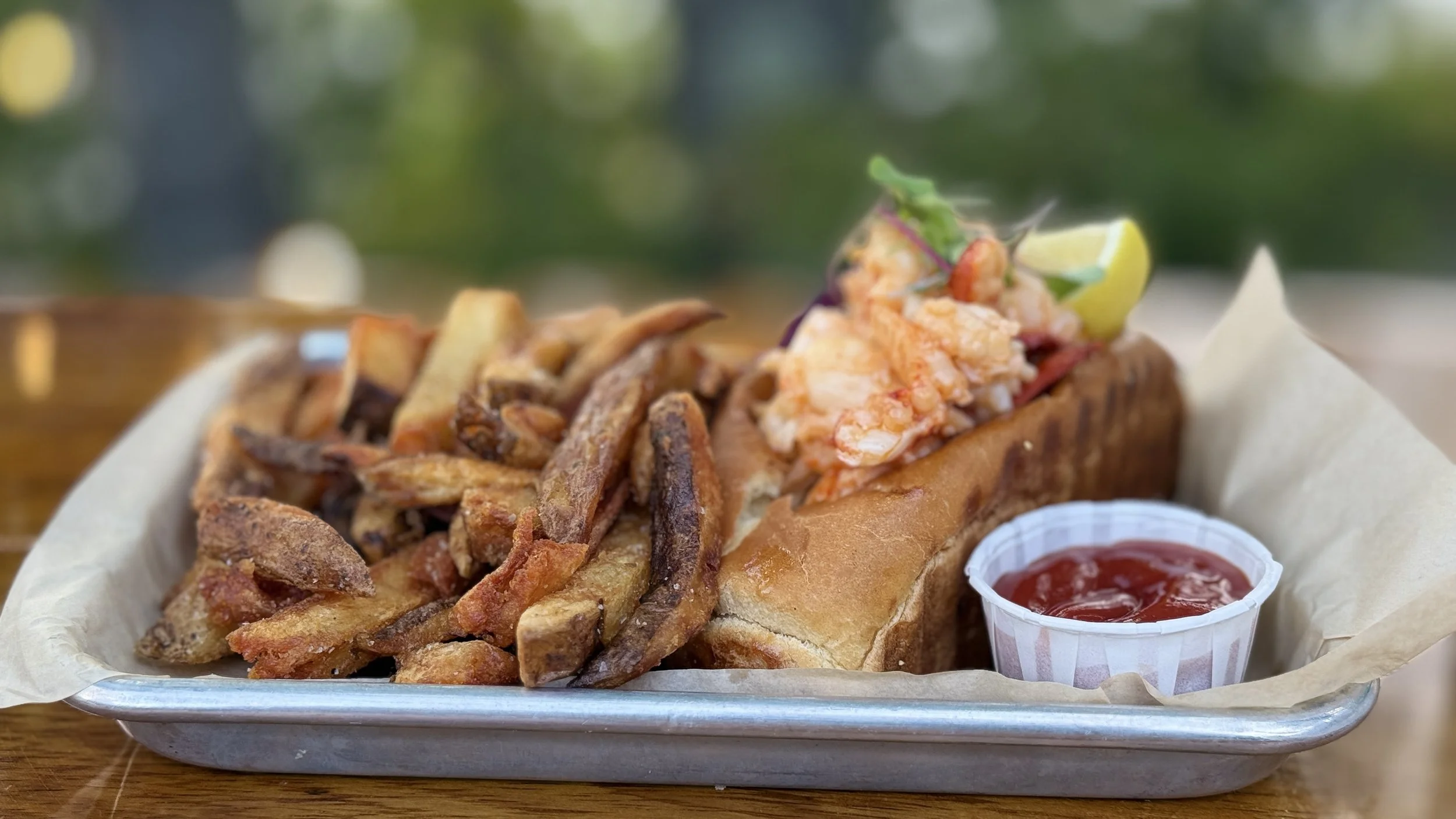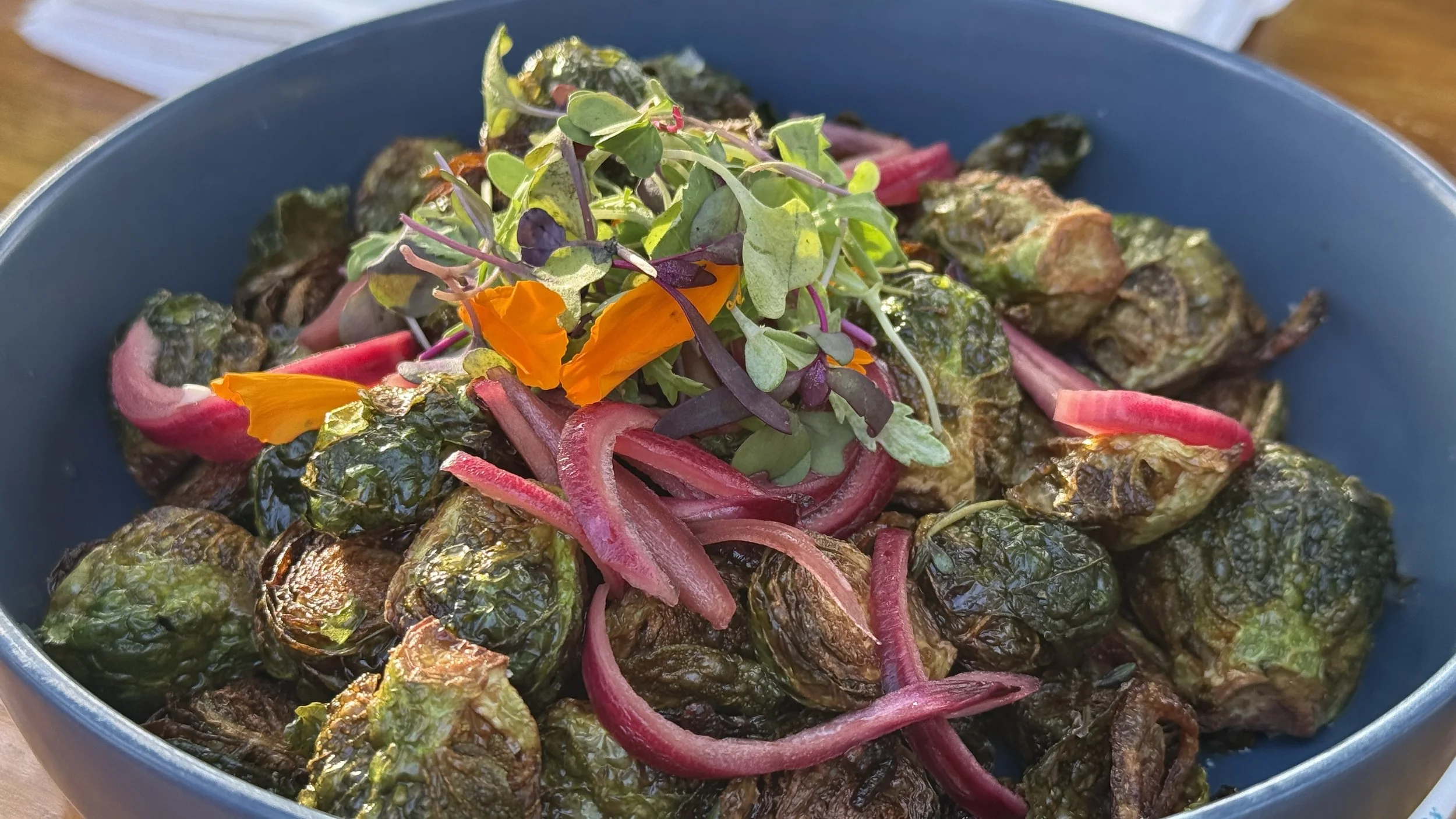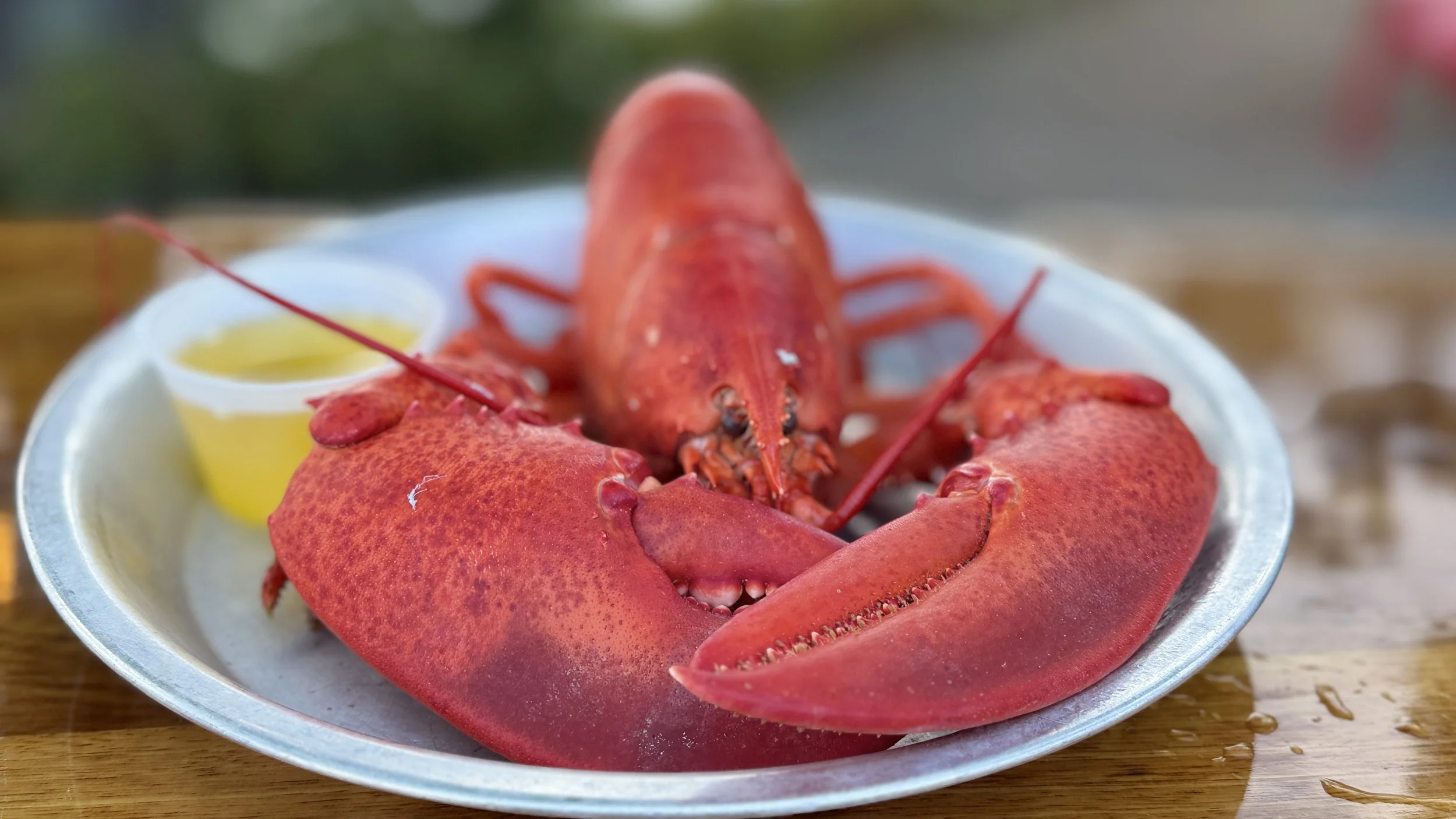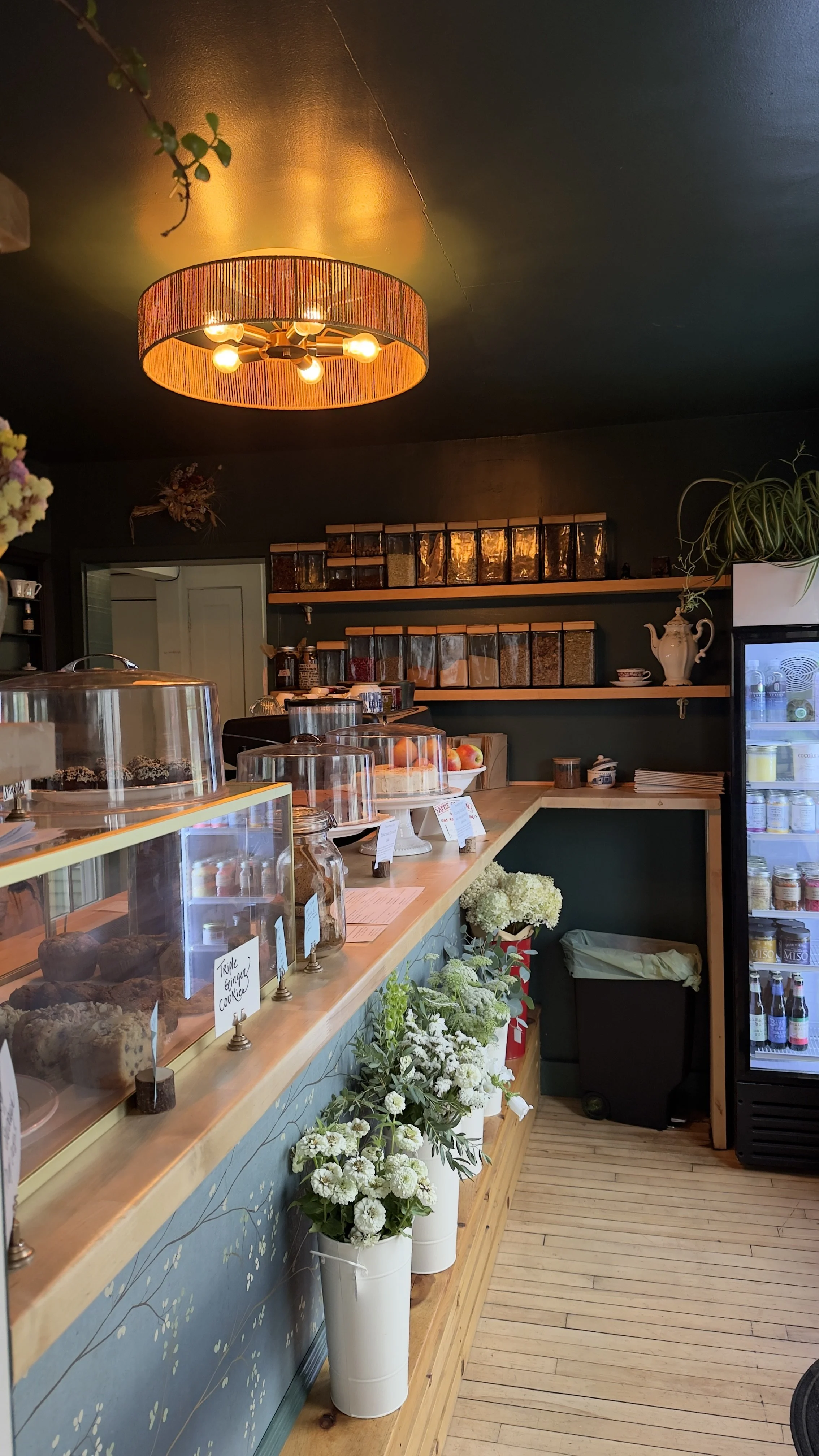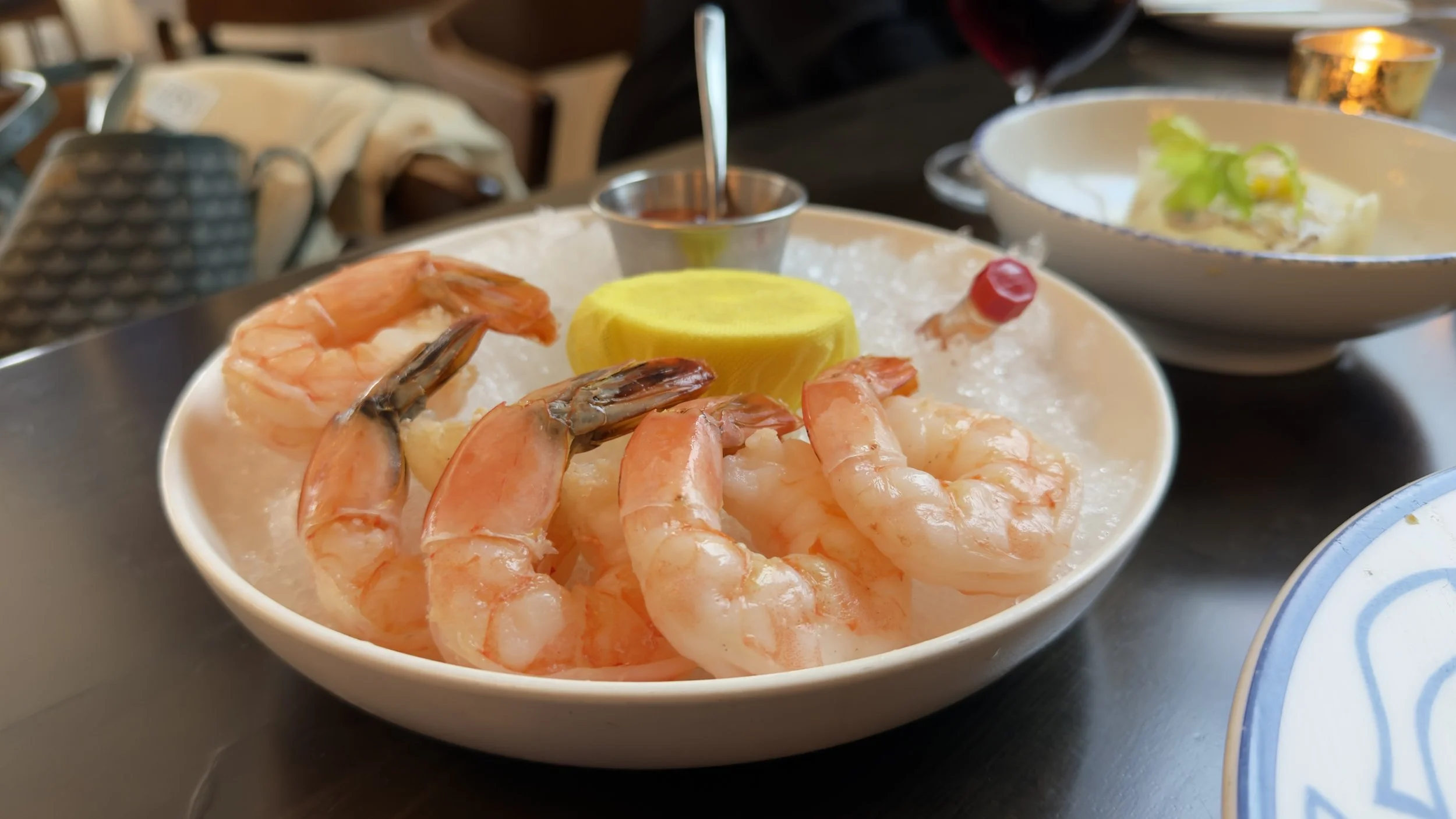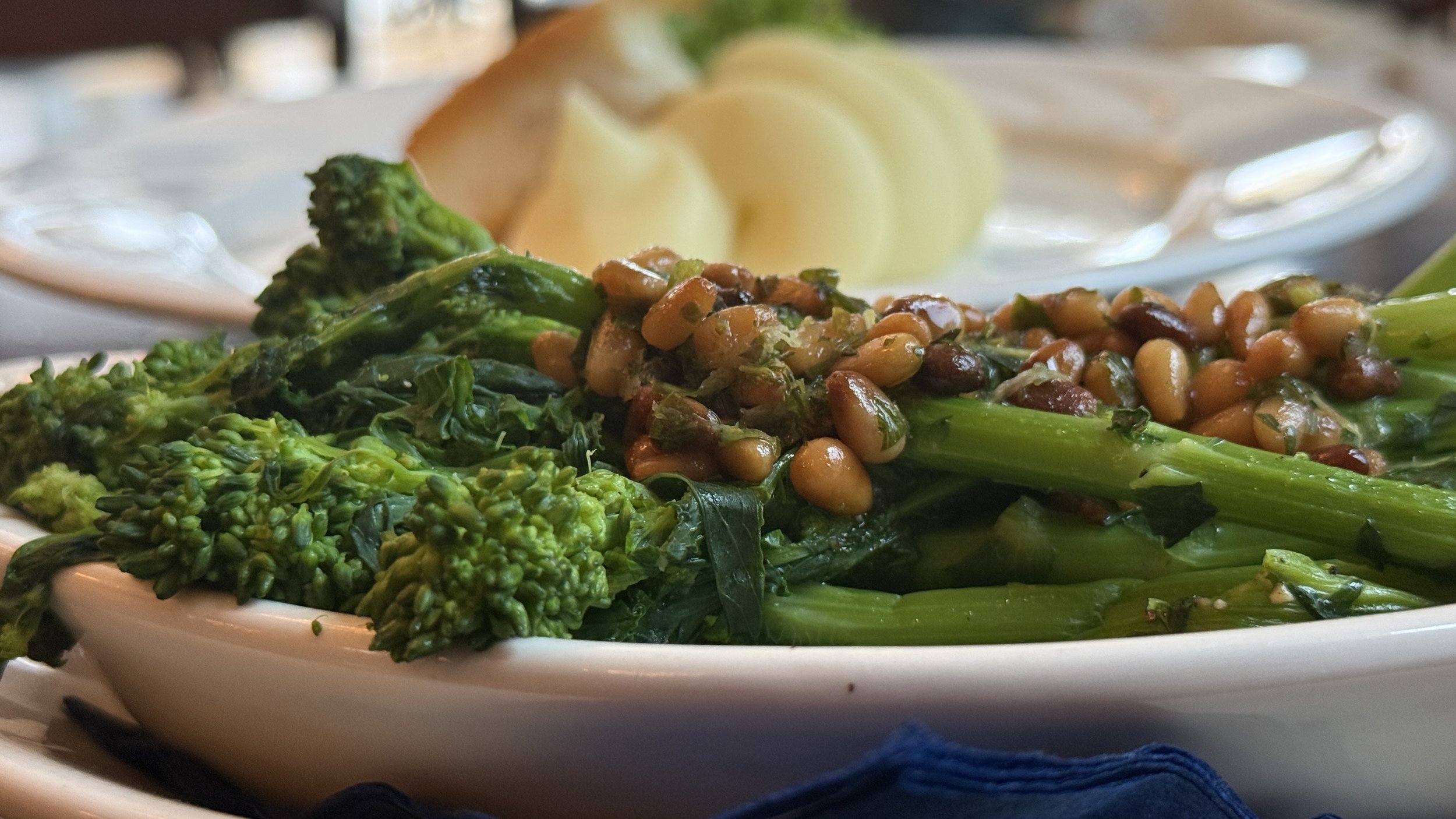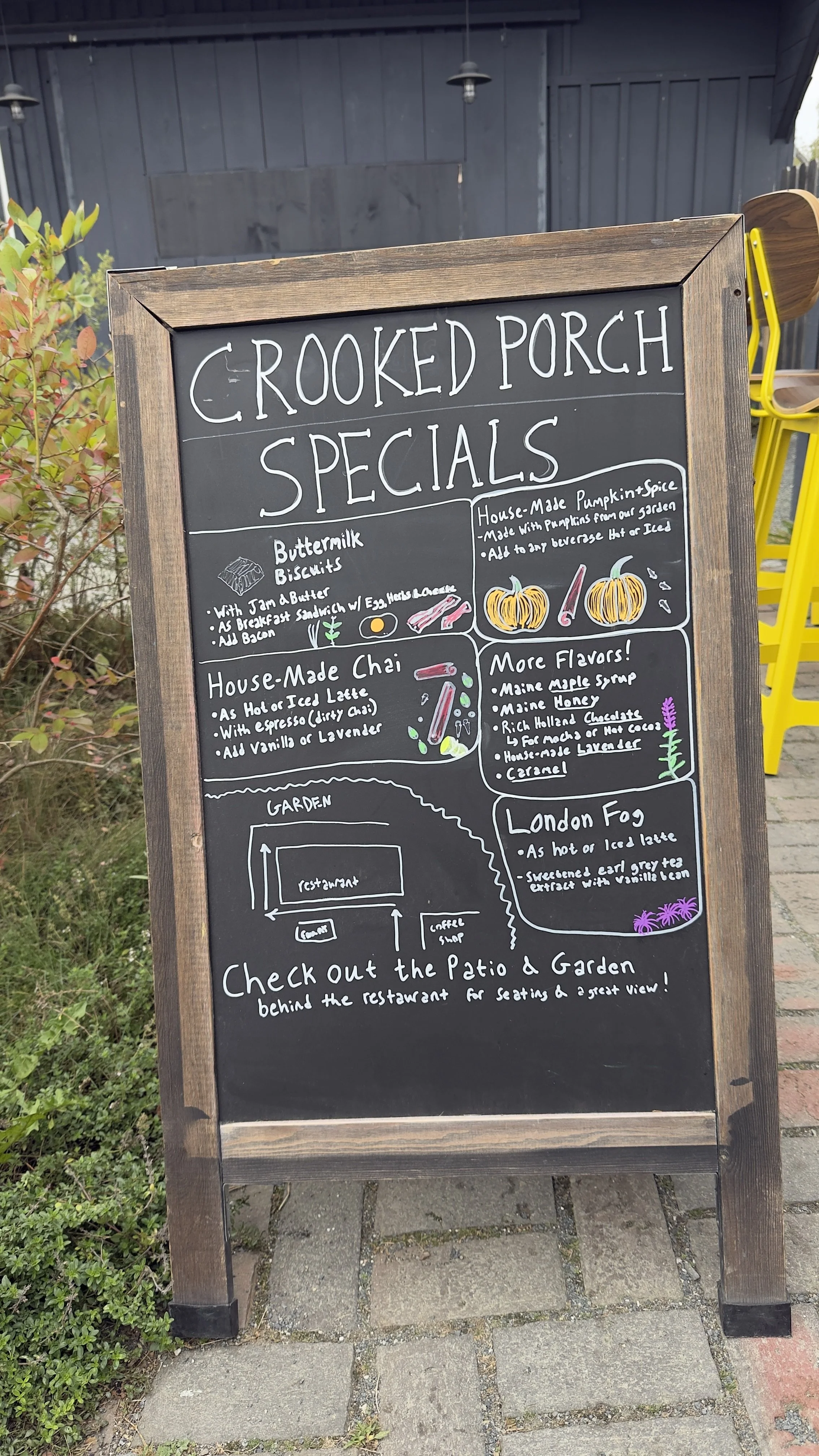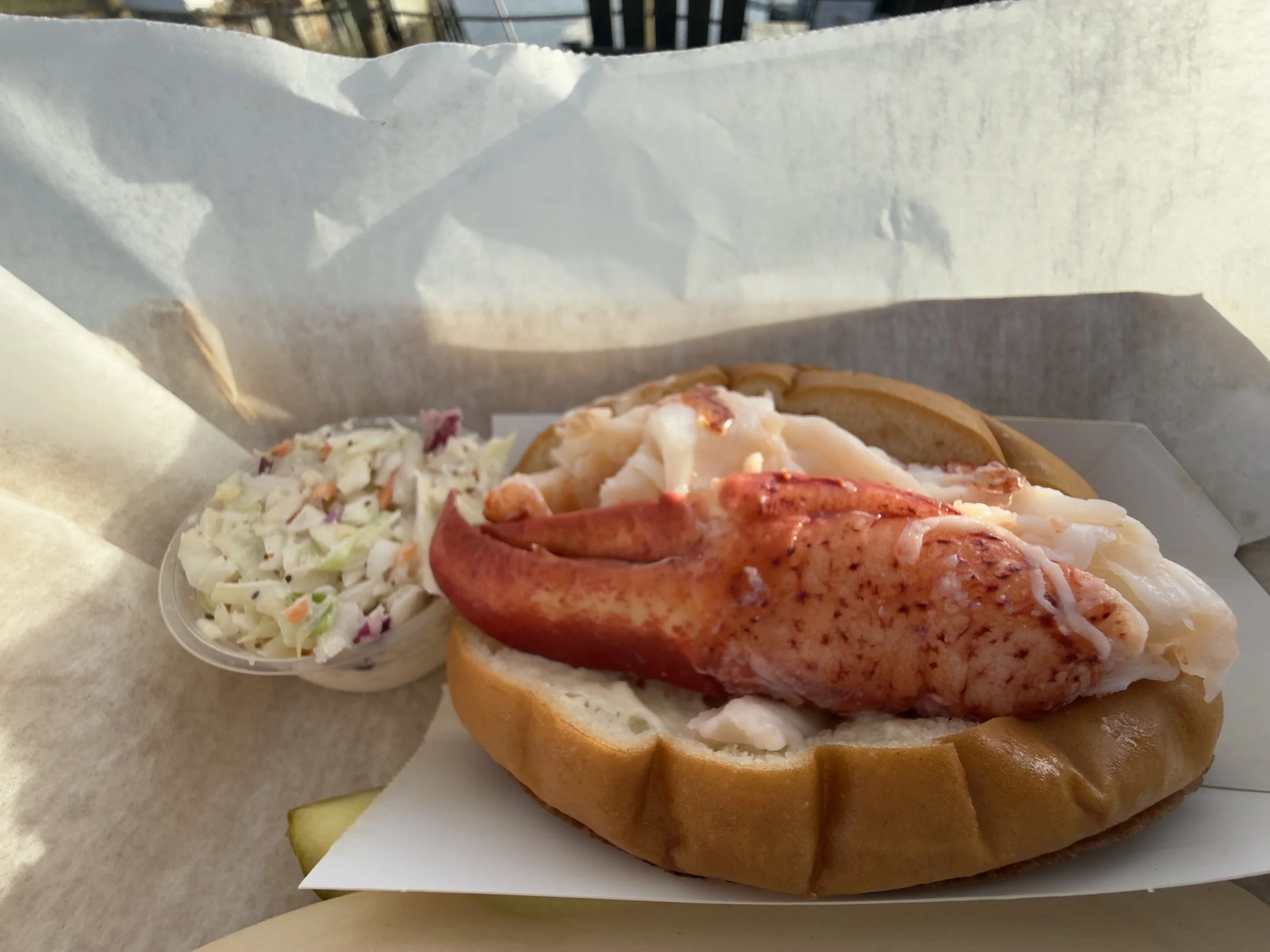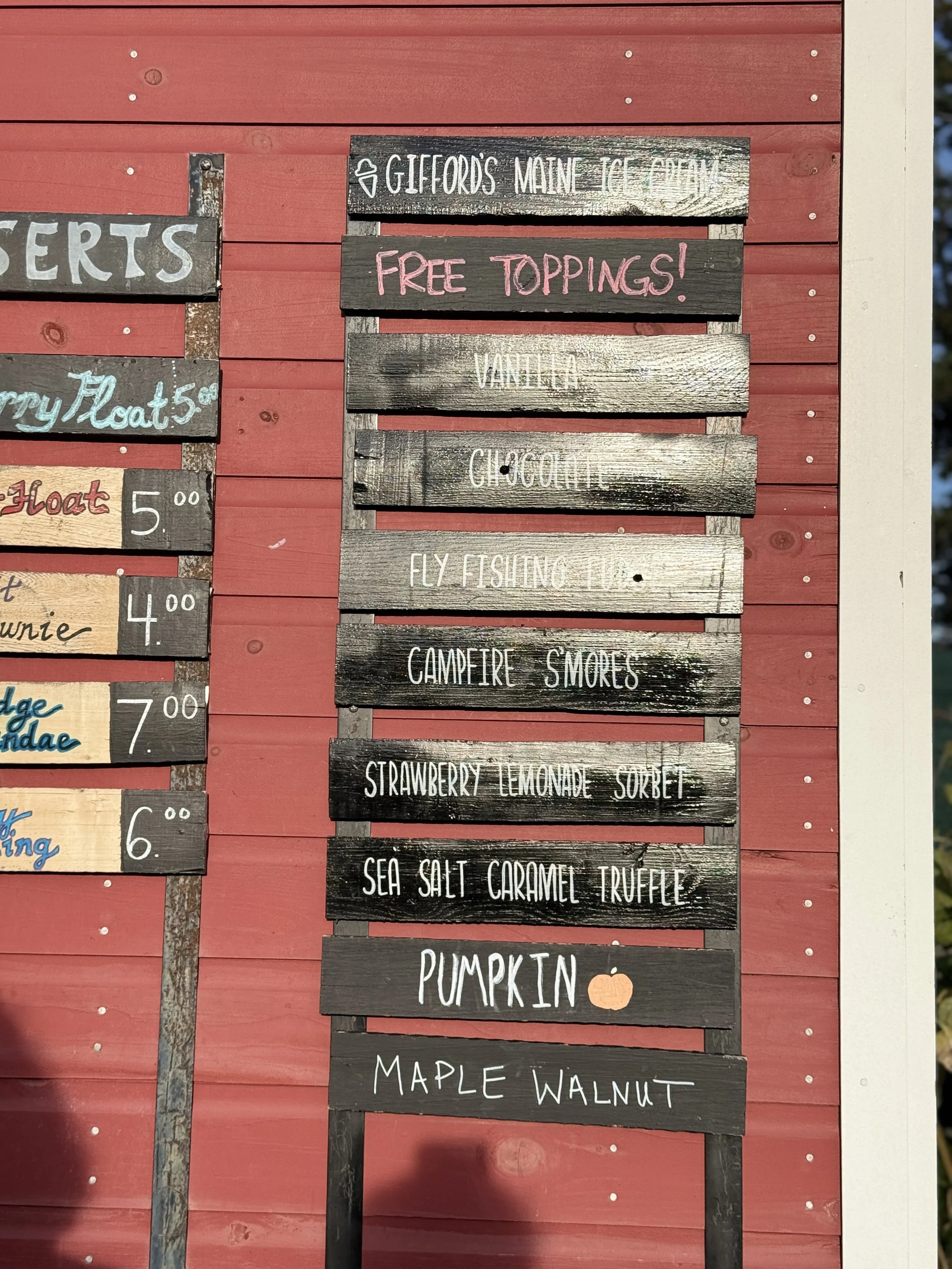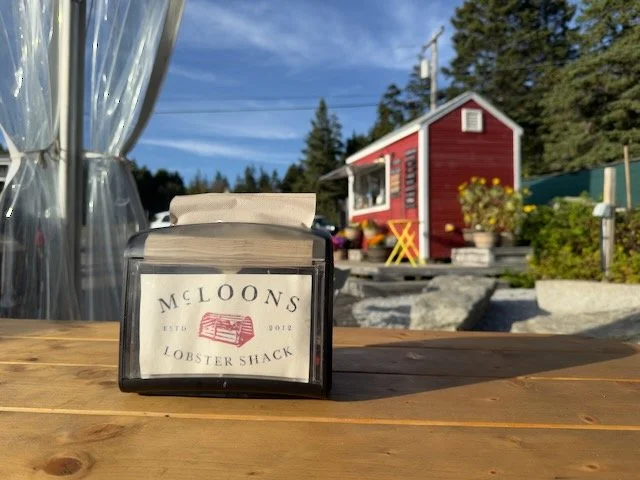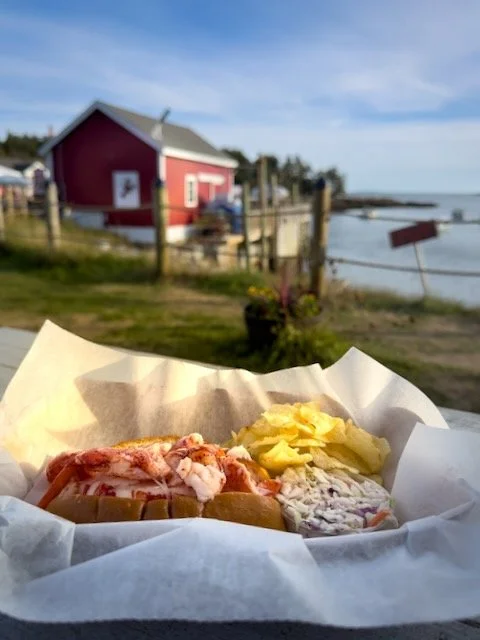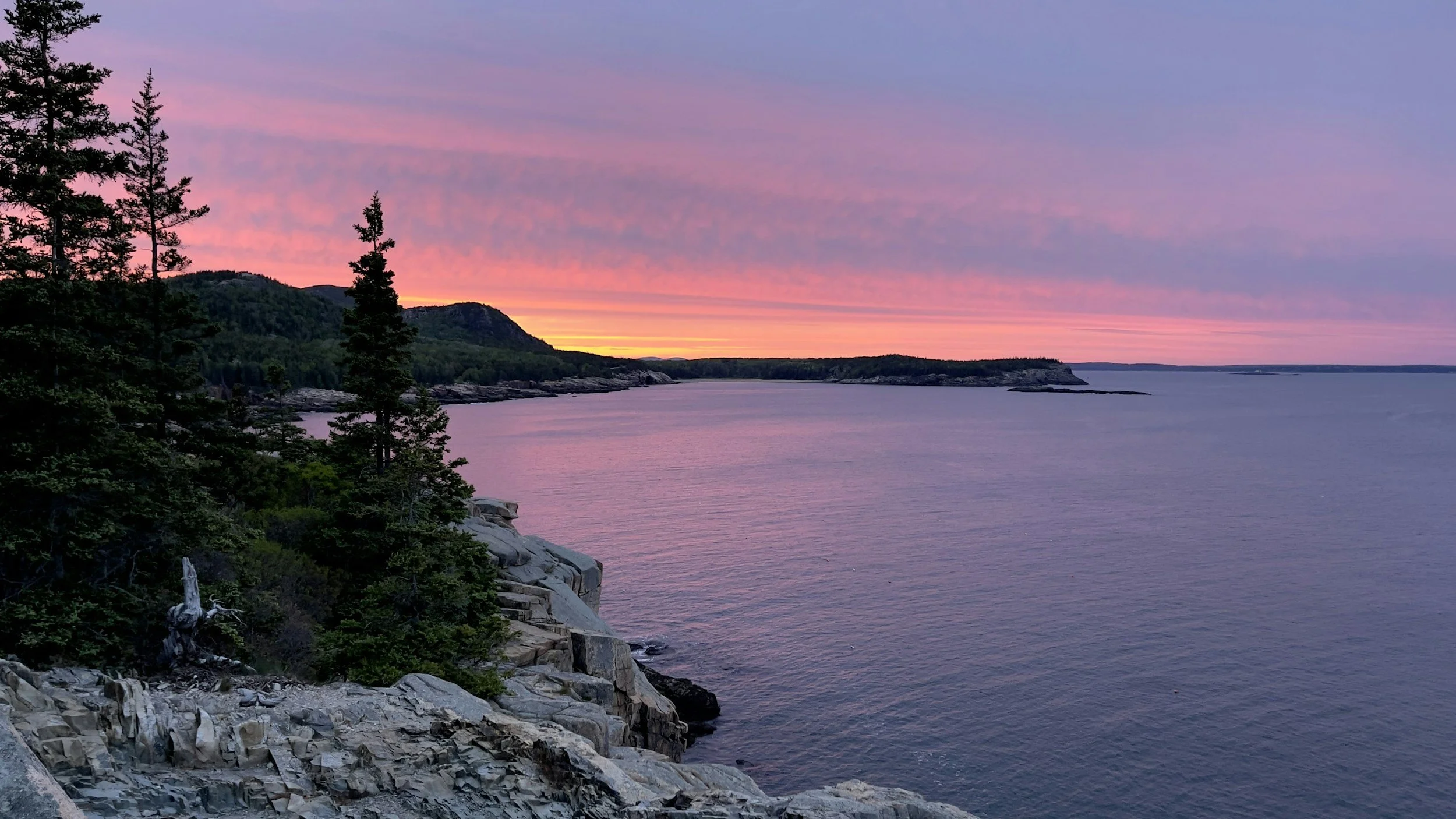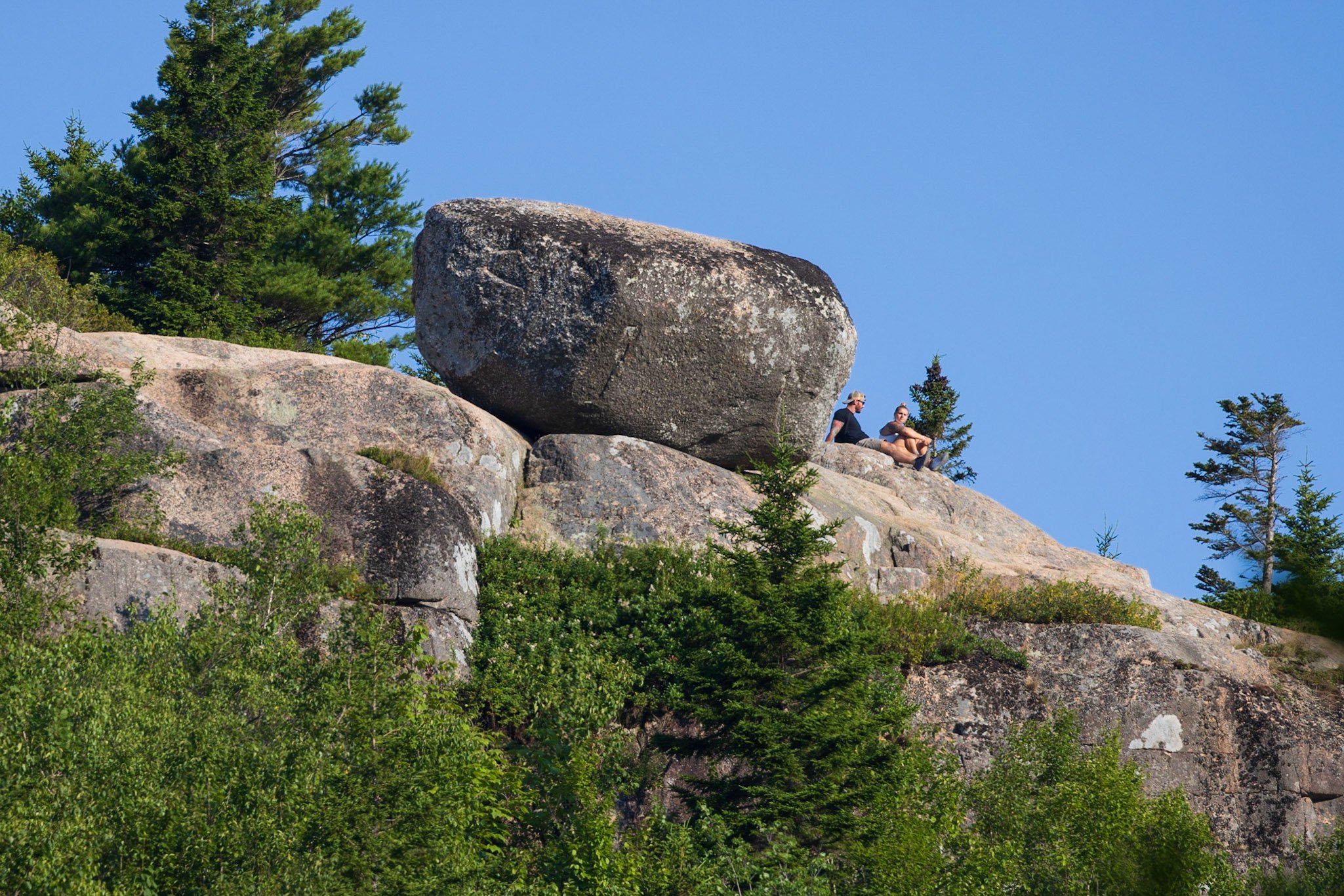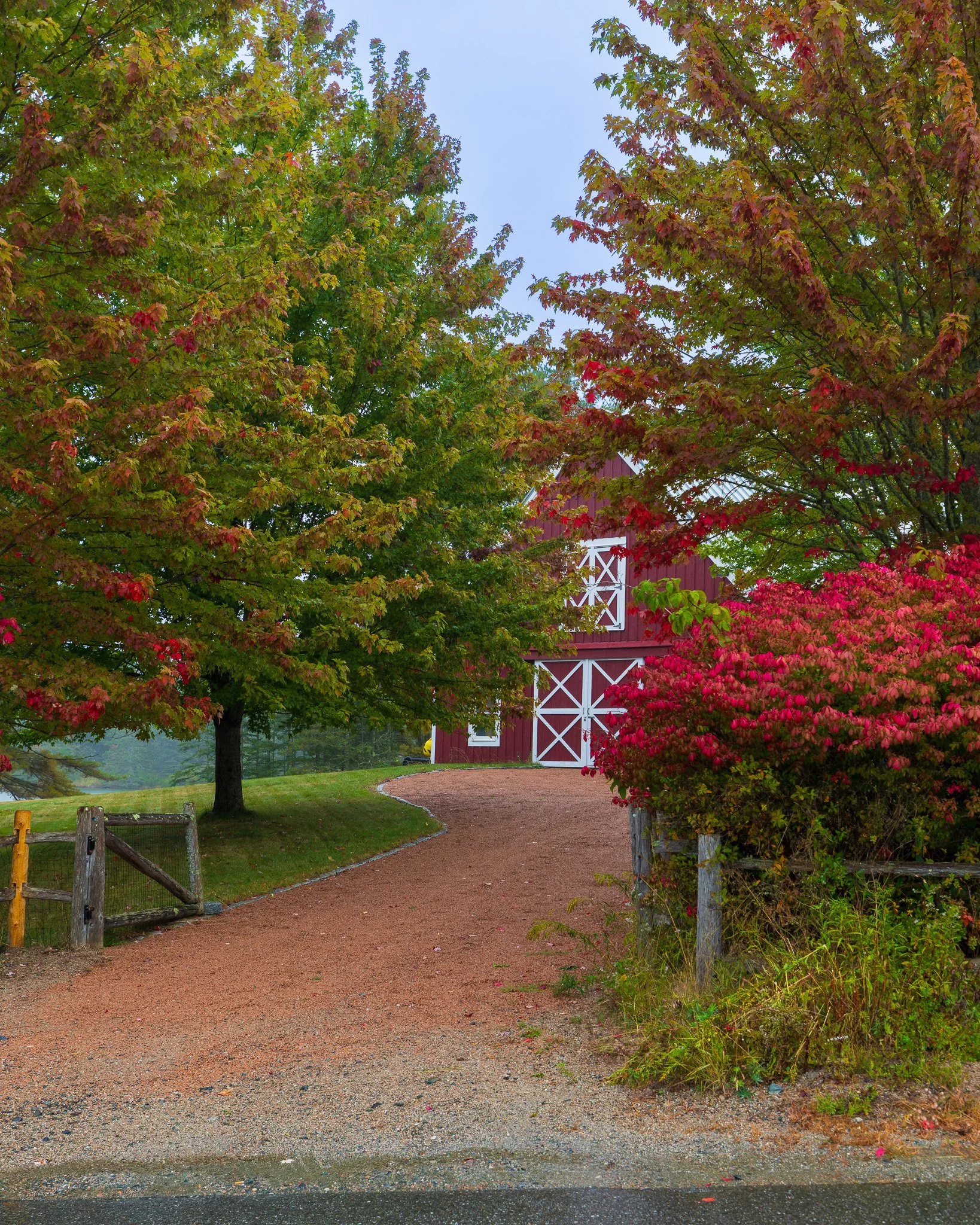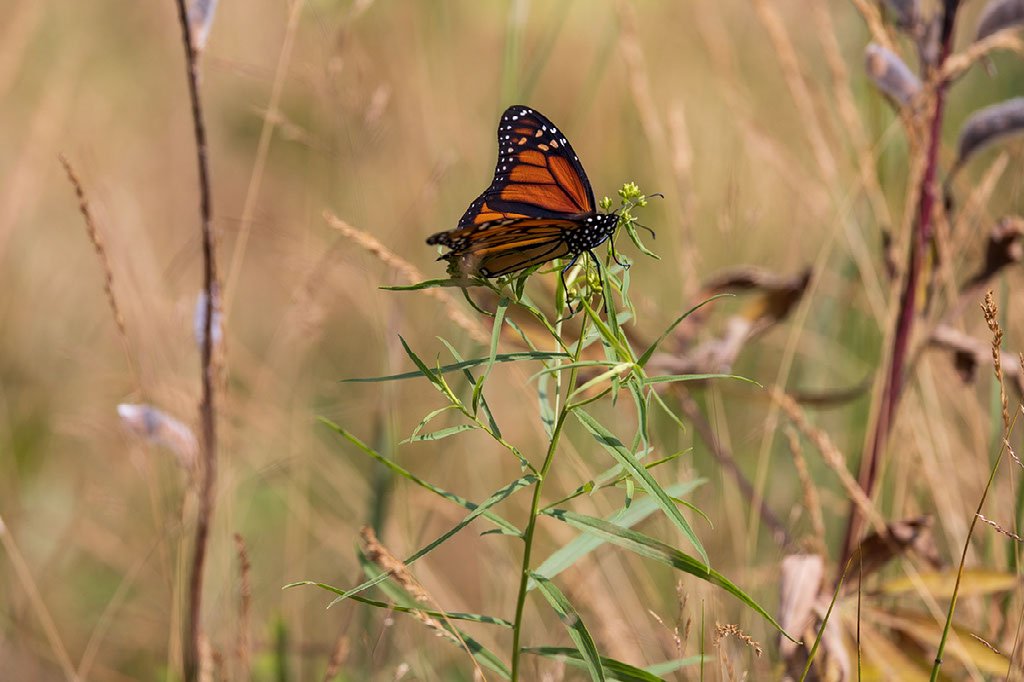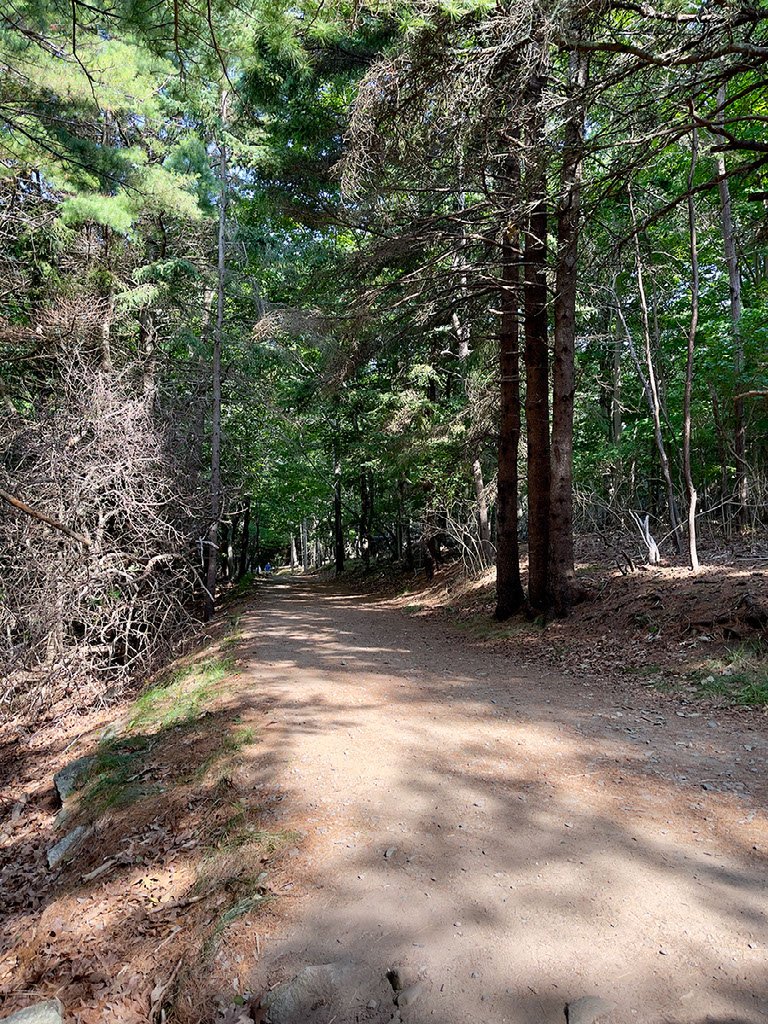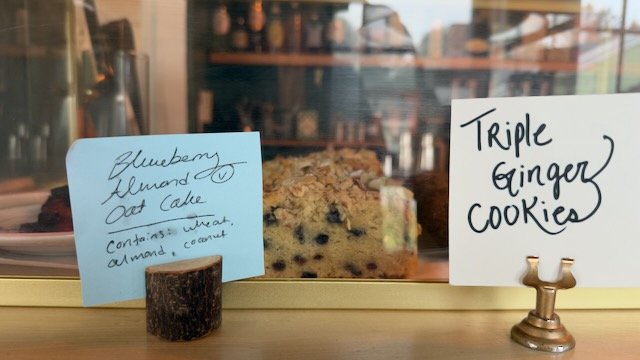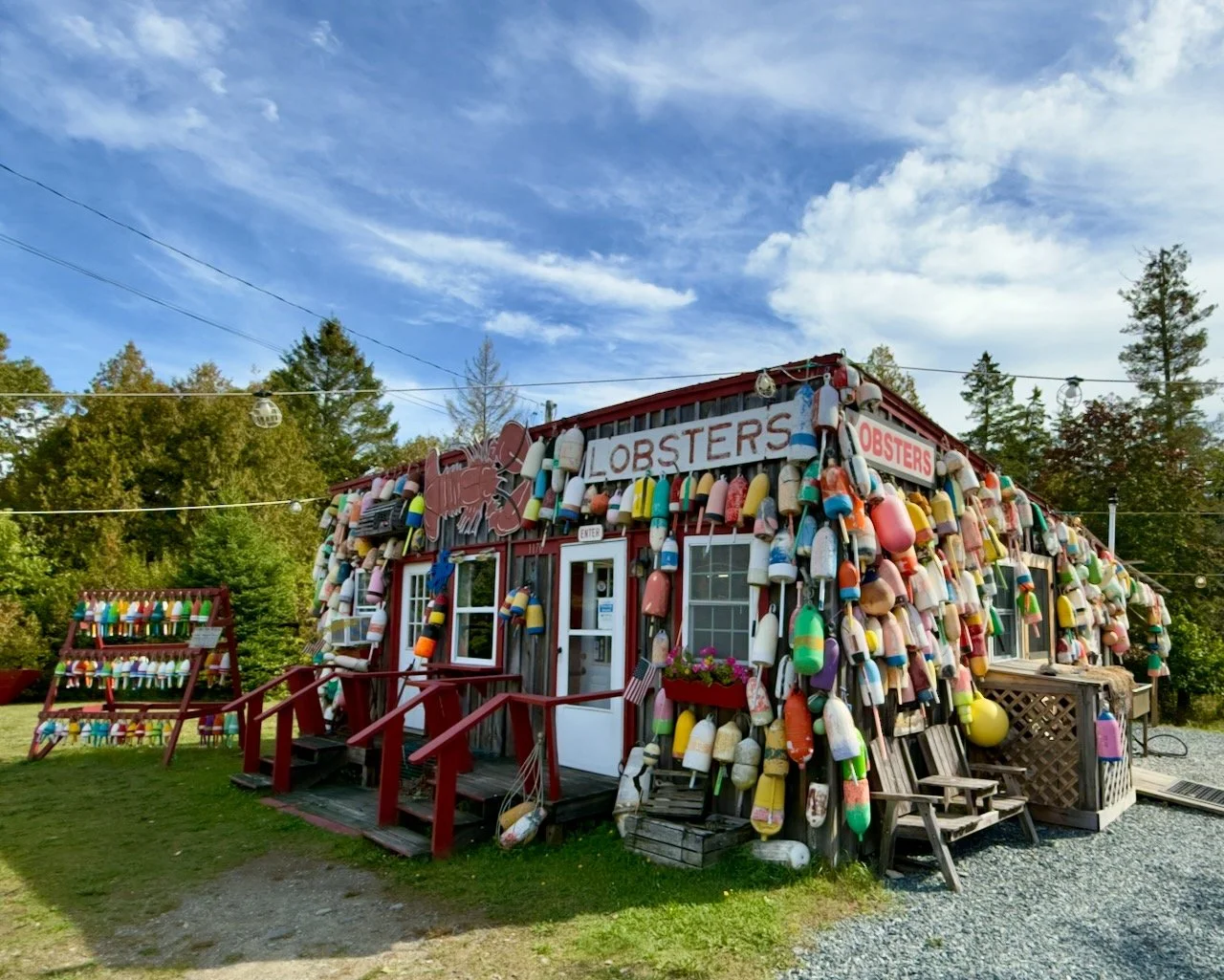My Photography & Travel Guide to Acadia National Park
The Light, the Coast of Acadia
Acadia is where the rugged Atlantic coastline meets the wild beauty of the Maine woods. It’s one of the few places in the U.S. where you can watch the sunrise from the top of a mountain, photograph waves crashing against pink granite cliffs, and enjoy lobster rolls in a seaside village, all in the same day.
There’s something magnetic about Acadia’s blend of sea and mountain. It pulls you in and makes you want to come back.
Bar Harbor Hotel at Sunrise
Over the years, I’ve visited Acadia in both summer and early fall, and each season feels like a different park altogether. In summer, lupines bloom along carriage roads and lobster boats dot the harbors like toys scattered on blue glass. By late September, the park transforms into a painter’s palette, fiery reds, amber birch leaves, and deep evergreen contrasts that make every frame feel cinematic. If I could only choose one time of year to visit, it would be late September/early October.
For photographers, Acadia is pure magic. The diversity of landscapes, featuring rugged cliffs, still ponds, granite peaks, and quiet coves, means you can capture sunrise, mist, forest light, and starry skies all in the same day. It’s a compact park, but visually vast. Whether you’re taking photos with a mirrorless camera or simply using your iPhone (Android), Acadia rewards anyone willing to chase the light.
In this Photography & Travel Guide to Acadia National Park, I’ll share my favorite photo locations (and when to shoot them), where to stay and eat in nearby Bar Harbor, how to plan a relaxed photography itinerary, seasonal photo advice, and tips for photographers. Whether you’re coming for your first visit or returning for your tenth, Acadia will find new ways to surprise you.
Acadia National Park at Sunset
“Maine, during the summer, is really heaven on earth.”
📅 Ideal Duration of Stay in Acadia National Park
For a photography-focused trip, four to six days in Acadia feels just right. The park may appear small on a map, but its variety of landscapes, ocean cliffs, lakes, forests, and mountain summits deserves time to appreciate. You’ll want slow mornings chasing fog over Jordan Pond, golden sunsets at Bass Harbor, and unhurried afternoons exploring Bar Harbor’s shops and cafés between shoots.
Below is a relaxed five-day itinerary designed with photographers in mind, a balance of golden-hour shoots, downtime for editing, and room for serendipity.
Day 1 – Arrival & Shore Path Sunset
Settle into your hotel in Bar Harbor and take an evening walk along the Bar Harbor Shore Path. The path hugs the coastline and offers your first glimpse of Frenchman Bay. It’s an ideal spot for photographers, offering wide-angle landscapes, reflections, and golden light hitting the waves. Bring your 15–35mm lens or use your phone’s wide lens for sweeping compositions.
Early Morning in Bar Harbor
Day 2 – Sunrise on Cadillac Mountain & Jordan Pond Reflections
Make a reservation for the Cadillac Summit on Recreate.gov. Wake well before dawn to reach Cadillac Mountain, the first place in the U.S. to see sunrise part of the year. Arrive at least 45 minutes early; the light transitions fast from deep blue to soft gold. Use your 70–200mm for compressing the islands below, or an iPhone tripod for crisp low-light shots. After breakfast, head to Jordan Pond, where the famous Bubbles reflect perfectly in calm water. Late morning light works beautifully here when the winds are low.
Sunrise at Cadillac Mountain
Day 3 – Carriage Roads & Eagle Lake
Spend the day on the park’s historic Carriage Roads, a network of stone bridges and forested trails built by John D. Rockefeller Jr. They’re ideal for capturing texture and symmetry. Bikers and horseback riders add human interest to your frames. In the late afternoon, make your way to Eagle Lake for mirror-like reflections. Smartphones excel here in Portrait mode; DSLRs benefit from a polarizer to manage glare.
Day 4 – Beehive Trail & Sand Beach
If you’re comfortable with heights, hike the Beehive Trail early for panoramic views of Sand Beach and the Atlantic. The climb is short but steep, and the morning light spills beautifully across the cliffs. If you want a more relaxed option, Jesup Path, is an incredible area to take a morning walk. It is accessible from the Sieur de Monts area.
Afterward, relax on Sand Beach, a great spot for capturing wave motion with ND filters. Evening brings soft pastel skies over the bay, perfect for minimalist compositions.
Day 5 – Bass Harbor Head Lighthouse & Bar Harbor Night Shots
End your trip with a sunset at Bass Harbor Head Lighthouse, one of Acadia’s most iconic scenes. Arrive an hour early to secure a spot on the rocks. Parking can be very challenging, so it’s essential to arrive early. Use a tripod for long exposures as waves crash against the granite below. iPhone users can steady their phones on nearby rocks and use Night Mode for surprisingly good results. Back in Bar Harbor, finish the night photographing harbor lights reflecting off the water — a quiet, fitting finale.
Where to Stay in Acadia National Park
Most visitors base themselves in Bar Harbor, the charming coastal town that sits right on Acadia’s doorstep. For photographers, it’s ideal — close to sunrise spots like Cadillac Mountain, the Shore Path, and Jordan Pond, yet lively enough to unwind with good food and ocean views after a long day of shooting. Bar Harbor also offers easy access to the park loop road, making early-morning starts painless (and trust me, you’ll want to be out before dawn).
If you prefer quieter scenes, consider Northeast Harbor or Southwest Harbor, both of which are within a 25-minute drive of Bar Harbor. These harbors are sleepier and feel more “local Maine,” with working docks and soft morning light perfect for photographing lobster boats and misty reflections.
Here are a few hotel recommendations I’ve personally enjoyed or would recommend to fellow photographers:
Bar Harbor Inn
Luxury Stays
Bar Harbor Inn & Spa – A classic for good reason. Its waterfront location offers panoramic views of Frenchman Bay, and sunrise shoots are as easy as stepping outside your room. I’ve photographed countless golden hours right from the lawn. The inn’s historic charm, white Adirondack chairs, and curved balconies make it feel timeless.
Claremont Hotel – Tucked in Southwest Harbor, this recently renovated property blends modern design with vintage coastal elegance. The sunsets here are spectacular — soft pink light over Somes Sound. It’s also a bit quieter than Bar Harbor, perfect for those seeking peace after a long day of exploring.
Asticou Hotel– Perched above the harbor in Northeast Harbor, the newly restored Asticou Hotel blends Maine’s maritime history with quiet, modern luxury. Initially built in 1883 and reopened in 2025 after a stunning renovation, it’s one of Mount Desert Island’s most iconic stays.
Mid-Range & Boutique Options
Sand Bar Cottage Inn – Set along Bar Harbor’s historic West Street, the Sand Bar Cottage Inn captures the charm of coastal Maine with a blend of classic elegance and modern comfort. Housed in an 1887 mansion and fully renovated in 2021, the inn feels like stepping into a seaside retreat from another era
Ivy Manor Inn – A charming B&B right in the heart of Bar Harbor with an intimate, historic feel. The ivy-covered facade photographs beautifully at dusk, and the walkability can’t be beat.
Harbor Ridge Resort – Located in Southwest Harbor, this resort is an excellent option for families or photographers seeking extra space. The elevated position offers sweeping views, especially in the fall when the foliage turns every ridge into a tapestry.
Pro Tip: If you’re visiting during peak foliage season (late September to mid-October), book your accommodations early — they fill up quickly. And if your main goal is sunrise and sunset photography, staying in Bar Harbor or Northeast Harbor provides the best access to both sides of Mount Desert Island without requiring long drives in the dark.
Near Boulder Beach
Best Time to Visit Acadia National Park for Photography
Acadia wears its seasons like a painter’s palette — every few months, the park changes character entirely. For photographers, that means there’s no wrong time to visit, only different kinds of magic.
Summer (June–August) brings long days, soft coastal breezes, and endless opportunities for seascapes. Mornings start early — around 4:30 a.m. — but the reward is golden light over calm harbors and lupines blooming along the carriage roads. Evenings glow with pastel skies over Sand Beach or Bar Island. Crowds are heaviest in July and August, so plan sunrise shoots early and explore quieter corners, such as Seal Cove or Pretty Marsh, in midday light.
Fall (September–October) is a time of pure poetry, and it's so rewarding to photograph during this season. By late September, maples and birches ignite the park in shades of crimson, orange, and gold. Mornings are cool and misty — ideal for reflections at Jordan Pond or Eagle Lake — while afternoons bring crisp blue skies and contrast-rich scenes. This is my favorite time of year to photograph Acadia. The low-angle autumn light wraps the granite cliffs in warmth, and the crowds thin just enough to make it feel peaceful again.
Spring (May–early June) is a quieter and often overlooked time. Trails reopen, waterfalls flow at their fullest, and the park feels raw and new. The greens are electric, the fog unpredictable, and the lighting soft — perfect for moody, minimalist compositions.
Winter (November–March) transforms Acadia into something entirely different. Snow dusts the pink granite, and frozen ponds mirror the pines. While many park roads close, you can still capture dramatic coastal scenes along Ocean Drive and hike snow-covered trails on snowshoes. Bring extra batteries — the cold drains them quickly — and experiment with black-and-white conversions for stark winter contrast.
If you’re planning your first photography trip, September through early October strikes the best balance of weather, light, and color. Days are crisp but not cold, the foliage is spectacular, and the low autumn sun creates golden hour that seems to last all day.
By Boulder Beach
Where to Eat (and Photograph) Around Acadia
After a morning of chasing fog and golden light, few things feel better than a strong coffee and a hearty Maine breakfast. Bar Harbor has plenty of restaurants catering to visitors, but the best meals — and coffee — often lie a short drive away. We tried many of the cafes in town, and the majority were not very good.
Some of our favorite finds were small, locally owned spots a short drive from town, where you can still taste the soul of coastal Maine without the crowds. Whether you’re after a sunrise espresso before heading to Cadillac Mountain or a lobster dinner with golden-hour views, these are the places that stood out.
Bar Harbor Favorites
Café This Way – A local institution tucked just off Mount Desert Street, known for creative breakfast and brunch plates. Morning light filters through the front windows beautifully — great for capturing food photography or candid traveler moments. Please arrive early to avoid the rush; by 9 a.m., it’s already buzzing.
Table Salt – Located in the center of Bar Harbor, Table Salt offers thoughtful dishes with a modern twist (Mussels, Calamari, Brussels sprouts, Halibut). They also have excellent cocktails.
Brasserie LeBrun – A wonderful surprise in the area — elegant French-inspired cuisine with refined service and a calm atmosphere. Beautifully plated dishes and flattering interior light make it a top pick for an evening meal. This was our favorite spot in Bar Harbor. Absolutely delicious!!
Seafood & Coastal Dining Favorites
Abel’s Lobster – A Mount Desert Island classic. We loved it. Picnic tables overlook Somes Sound — one of the most photogenic dining views in Maine. The golden-hour light reflecting off the water is spectacular. Order the steamed lobster or scallops and linger until sunset; you’ll want your camera handy—great food, drinks, and service.
The Travelin’ Lobster – A family-run, no-frills lobster shack serving fresh, locally caught lobster rolls. It’s casual, authentic, and the red picnic tables pop beautifully against the blue sky — great for relaxed travel shots.
Sassafras Café & Bakery – About a 15-minute drive from Bar Harbor, this little spot is worth the detour. The pastries and seasonal fruit tarts are exceptional — perfect for a post-sunrise treat or coffee stop between park adventures.
Sweet Pea’s Café – Tucked away just outside town, Sweet Pea’s sits on a small farm with outdoor tables surrounded by wildflowers. It’s a beautiful spot for lunch or dinner. An authentic farm-to-table experience. We love this place. They have incredible pizza.
Southwest Harbor & Northeast Harbor Gems
The Claremont’s Little Fern – Set inside the beautifully restored Claremont Hotel, Little Fern offers locally inspired dishes with one of the best sunset views in Acadia. The dining room’s coastal-modern design — think linen tones, wood, and glass — photographs beautifully during golden hour.
Quietside Café & Ice Cream Shop – A Southwest Harbor classic with outdoor picnic tables shaded by trees. Simple, friendly, and quintessentially Maine. The light here in late afternoon has that soft, honeyed glow perfect for lifestyle photography.
The Colonel’s Restaurant & Bakery – In Northeast Harbor, this spot feels like a time capsule in the best way. Expect homemade pastries, comfort food, and locals chatting over coffee. Early morning is best for photos — warm sunlight filters through the front windows, ideal for capturing natural food shots without harsh shadows.
Cafés for Photographers
Crooked Coffee Roasters – Located about 10 minutes from Bar Harbor, this cozy local roastery pours exceptional espresso and pour-overs. The staff knows their coffee, and the vibe is relaxed. Perfect for a quiet start before a sunrise shoot or after your morning shoot.
Coffee Matters – Another local gem just minutes from downtown. Great cappuccinos, friendly service, and an airy space that photographs well in the morning sun. A perfect pit stop before heading into the park.
Where to Eat Lobster Rolls....
You cannot go to Maine and not try a Lobster Roll, right? If you are driving up from Boston or Portland, then there is one spot that I would highly recommend. McCloons Lobster Shack.
McCloons
Maine lobster is the sweetest, most flavorful, and tender lobster on the market.
The Lobster is hand-caught daily so it is extremely fresh. The key to a great Lobster Roll is the freshness and simplicity of the ingredients. There are only three main ingredients: fresh lobster, bread, and mayo or butter dressing. Traditional Maine lobster roll restaurants serve this sandwich with french fries or potato chips on the side.
“Cold or Hot Lobster Rolls is the eternal question”
The traditional lobster roll is stuffed with premium lobster meat soaked in butter and served on steamed or grilled lobster roll bread. However, lobster rolls come in two types: hot with melted butter or cold with mayonnaise (and, sometimes, celery). While the cold one is known as the “traditional” preparation, the hot butter option is equally delicious. Which one is better?
McCloons
So, where are the best Lobster Rolls in Maine...Drum Beat. We have taken into account 2 factors the location and the taste of the Lobster Rolls. I think the 2 best Lobster Shacks are McCloons and the Foot Bridge Lobster Shack. McCloons is located on the way to Bar Harbor when driving up from Portland.
Our favorite Lobster Rolls in Maine are:
Best Lobster Rolls in Maine are McCloons (Wonderful Location and Lobster)
The FootBridge Lobster in Perkins Cove
Two Lights Lobster Shack in Cape Elizabeth
🚗 Getting Around Acadia National Park
Acadia is one of those rare places where the journey between photo stops is just as scenic as the destinations themselves. The park’s compact size makes it easy to explore, but good planning — especially around sunrise and parking — can make all the difference.
Along the Park Loop
Park Entry Passes
All visitors require an Acadia National Park Pass, which can be purchased online in advance or at several on-site locations, including the Hulls Cove Visitor Center. I would definitely buy a National Park Pass before visiting.
A 7-day vehicle pass costs approximately $35 per car and covers all occupants.
If you plan multiple national park trips, the America the Beautiful Annual Pass ($80) is a great investment. Keep your printed or digital pass handy — rangers often check at parking areas and trailheads. This is what we get each year. It pays for itself after just 3 to 4 visits to a National Park.
For sunrise on Cadillac Mountain, you’ll also need a vehicle reservation (available only from mid-May through late October). These sell out quickly, so reserve your spot as soon as the booking window opens on Recreation.gov. They sell 30% of tickets for the Summit Road 90 days in advance and the remaining 70% become available at 10 am 2 days before your preferred date.
Without it, you can still hike up, but you won’t be able to drive to the summit.
Driving the Park Loop Road
The 27-mile Park Loop Road is Acadia’s visual backbone. It winds past most of the park’s icons — Sand Beach, Thunder Hole, Otter Cliffs, Jordan Pond — and offers constant photo stops. The light changes dramatically as you circle Mount Desert Island, so I often drive it clockwise early in the morning and again near sunset.
Tip: Plan your drive on a weekday if possible. Parking can fill by mid-morning, especially near Jordan Pond and Cadillac.
Free Island Explorer Shuttle
If you’d rather not worry about parking, take the Island Explorer Shuttle — it’s free, eco-friendly, and connects Bar Harbor with most park highlights from late June through early October. Buses are clean and have racks for small gear bags. It’s a great option if you’re staying in Bar Harbor and want to photograph without hauling a car around.
Biking & Walking
Acadia’s Carriage Roads are perfect for cycling or slow-paced photo walks. Their stone bridges, shaded paths, and lake reflections reward patience and a sense of exploration. I often bring my lightweight mirrorless setup or just my phone on these rides — the slower pace helps you see compositions you’d miss from a car.
Photography Gear & Tips
One of the best things about photographing Acadia is that it rewards both minimalist and gear enthusiasts. Whether you’re driving up to Cadillac Summit at sunrise with just your phone or setting up a tripod on the cliffs of Bass Harbor, the park’s changing light and scenery will push your creativity in the best way.
Sunrise at Boulder Beach
I brought my Canon R5 Mark II with two lenses — the 15–35mm f/2.8 and 70–200mm f/2.8 — and found that combination covered nearly everything. The 15–35mm was perfect for wide landscapes at sunrise and interiors like the stone bridges along the Carriage Roads. The 70–200mm let me isolate details: sailboats in Frenchman Bay, or the distant islands bathed in morning haze.
If you’re traveling light, a single zoom lens, such as a 24–105mm or 24–70mm, is a fantastic all-around choice. Add a circular polarizer to cut glare on the water and deepen the blues of the sky, and an ND filter if you plan to capture wave motion or long exposures at Bass Harbor Lighthouse.
A sturdy yet lightweight tripod is essential for capturing sunrise, sunset, and long-exposure shots. I like carbon fiber models for portability. Don’t forget extra batteries and memory cards — Acadia’s variety will keep you shooting nonstop.
If you’re into wildlife, the occasional osprey, seal, or bald eagle may appear, especially around the harbors. In that case, a telephoto lens (100–500mm range) adds flexibility.
My Favorite Locations In Acadia National Park & Bar Harbor
Acadia's coast is the most photographed (and easiest to access) part of the park. A stretch of the Park Loop Road, known as Ocean Drive, winds along the coast for nearly 5 miles from Sand Beach to Hunter's Head. Many of Acadia's most well-known and photogenic locations are along this section of Acadia’s coast. Make sure you stop at Sand Beach, Thunder Hole, Monument Cove, Boulder Beach, Otter Cliffs, Little Hunter’s Beach, and Hunter’s Beach as you make your way down Ocean Drive.
Sunrise at Cadillac Mountain
My Top Acadia Photo Locations
1. Cadillac Mountain
📍 Google Maps
Cadillac Mountain is Acadia’s crown jewel — the first place in the U.S. to see sunrise for much of the year. From the summit, the islands of Frenchman Bay spread out like stepping stones in gold light.
Sunrise above the clouds
The drive up to the top of Cadillac Mountain takes about 10-15 minutes on Summit Road. The entire drive-up provides stunning views. The nice thing about Cadillac Mountain, apart from the views, is that there is a huge parking lot.
One of Acadia's most popular things is driving up to Cadillac Mountain, the highest point on the East Coast. From the top, you will see a spectacular sunrise. The only thing is that to get to the top, you need to get a reservation on Summit Road, which should be done well before your trip.
Pro Tip (DSLR): Bring a wide lens (15–35mm) to capture the sweeping view, but also switch to your 70–200mm for compressed, layered shots of the islands through morning haze. Arrive 45–60 minutes before sunrise and use a tripod with a graduated ND filter to balance the bright horizon.
Quick Tip (iPhone): Turn on HDR and lower exposure slightly to preserve color in the sky. Use Panorama mode for an easy, immersive result.
2. Jordan Pond & The Bubbles
📍 Google Maps
This is Acadia’s postcard — a perfect mirror of the twin Bubbles mountains reflected in still water. Early morning is best, before the breeze disturbs the surface.
The easy and better location is the South End. On the south end, there is plenty of parking and you only need to walk about 100 yards on a flat smooth trail.
Pro Tip (DSLR): Arrive 30 minutes before sunrise. Use a tripod and polarizer to control reflections and bring out underwater rocks in the foreground for added texture.
Quick Tip (iPhone): Shoot from a low angle to include reflections. Tap to focus on the reflection itself to lock exposure.
Sunrise at the Southern Point of Jordan Pond
There are 2 places to photograph Jordan Pond. The north end and the south end of the Pond. We arrived at the North End first, and I did not realize there was a South End. #notprepared
As I got out of the car, my wife warned me that it was better to go to the South end. So naturally, I did what every male does: I decided not to listen to her advice and walk to the top of the North End. That was a bad decision!! After about two minutes, the trail became quite rocky. Then it got very steep. At this point, a wise person would say it is not worth it. But not this guy!!!
So I kept going, and it got steeper and steeper. At the point where there are ropes on the trail to help you climb, I should have turned around. No, of course, I did not do that. After a 40-minute, very steep hike, I reached the top, and it was beautiful, but not as nice as the South End.
Do not miss photographing the "Bubble Rock".
Bubble Rock
So I get back to the car and notice that special way my wife can look at me with empathy while thinking that I am an idiot. So my wife asked me, "Did you see the bubble rock?" I looked at her, wondering what she was talking about. She then tells me that's why people climb up there!! That was not my proudest moment!!
View from the North End
3. Bass Harbor Head Lighthouse
One of the most photographed lighthouses in the U.S. — and for good reason. The sunset turns the granite cliffs and waves into a glowing copper.
The lighthouse is at the southwest corner of Mount Desert Island. It will take you about 45 minutes to reach Bar Harbor. Keep in mind that this is not only a very popular location, but it also has minimal parking.
Once you park your car, you need to descend the wooden stairs to the shoreline. I think it is best to shoot it at sunset, with the sun setting behind the lighthouse, providing a lovely backdrop for the sunset. You can find a comfortable place on the rocks and use them for the foreground. The only issue to be aware of is that the rocks can be very slippery. So get there early and be careful!
Pro Tip (DSLR): Get there at least an hour early; space on the rocks fills fast. Bring your tripod and a 6-stop ND filter to blur wave motion against the cliffs. Compose with leading lines from the rocks to the lighthouse.
Quick Tip (iPhone): Use Night Mode or a long-exposure app like Spectre. You can hold your phone steady against a rock for crisp results.
Sunset at Bass Harbor
4. Sand Beach & Thunder Hole
📍 Google Maps
Sand Beach sits between dramatic headlands, where morning light floods the sand and mist drifts in from the Atlantic. Just down the road, Thunder Hole offers powerful wave action that’s best a few hours before high tide.
Pro Tip (DSLR): Use your wide-angle for Sand Beach at sunrise, then move to Thunder Hole with a mid-telephoto lens to freeze the splash. A fast shutter (1/1000 sec or higher) captures the spray perfectly.
Quick Tip (iPhone): At Sand Beach, switch to the wide lens for drama; at Thunder Hole, shoot in burst mode to catch the wave at its peak.
Thunder Hole
5. The Coastline along the Park Loop (Sand Beach, Thunder Hole, Monument Cove, Boulder Beach, Otter Cliffs, Little Hunter’s Beach, and Hunter’s Beach)
📍 Google Maps
The drive along the Park Loop is stunning. I would advise shooting this area at Sunrise when there are limited numbers of people walking around. There are plenty of spots to pull your car over so that you can get out and take photos.
Sunrise along the Park Loop
What makes the Maine Coast in Acadia National Park so different is the large rectangular boulders along the coast. Make sure you stop at Sand Beach, Thunder Hole, Monument Cove, Boulder Beach, Otter Cliffs, Little Hunter’s Beach, and Hunter’s Beach as you make your way down Ocean Drive.
Boulder Beach at Sunrise
6. Otter Cove
While parts of Acadia are crowded, the particular area around Otter Cove offers spots where you can compose without intrusions. One note from a photographer said that although the cliffs are popular, a vantage they found “has been completely isolated every time” they visited
Otter Cove early Morning
Pro Tip (DSLR): Bring a tripod and 24–70mm lens. Compose from the creek below for leading lines under the arches. Use a polarizer to reduce glare on the water.
Otter Cove
Quick Tip (iPhone): Frame the bridge symmetrically using the grid feature and shoot vertically for dramatic perspective.
7. Wild Gardens of Acadia
At the Wild Gardens of Acadia, you can see over 400 native plant species in thirteen sections designed to represent natural plant communities found within Acadia National Park. Habitats such as mountain, heath, seaside, coniferous forest, and nine others are represented.
Pro Tip (DSLR): Arrive before sunset with a 70–200mm lens to capture the last warm light filtering through the pines. Long exposures here create a tranquil mood.
Quick Tip (iPhone): Use the wide lens at low tide for reflections and play with symmetry between sky and sea.
8. Asticou Azalea Garden
The Asticou Azalea Garden in Northeast Harbor, Maine, is not actually part of Acadia National Park but is an important place to consider visiting while in the area. Originally built in 1956-1957, largely due to the vision and passion of Charles Savage, it has undergone several major revisions since then.
The current garden design includes several interwoven pathways allowing visitors to discover new visual delights and aromas. Little benches and stone seats are strategically placed throughout, allowing you to sit and reflect.
Asticou Azalea Gardens
Pro Tip (DSLR): Bring your tripod and shoot early before sunrise fog lifts. The low contrast works beautifully for soft, painterly edits.
Quick Tip (iPhone): Turn on Live Photo mode and scroll through frames later to pick the one with the best reflection or bird movement.
9. Jesup Path
Jessup Path in Acadia National Park is one of those places that photographers quietly fall in love with. It’s not dramatic like Cadillac Mountain or thunderous like the coast at Schoodic Point, but it’s pure visual poetry when you catch it in the right light.
Jessup Path is famous for its white birch and poplar trees lining a long, elevated wooden boardwalk. The path cuts through a peaceful meadow that glows gold in late afternoon light and turns into a tapestry of color in the fall. The natural symmetry of the birch trunks and the curve of the boardwalk make it a perfect leading-line composition that pulls the viewer’s eye into the frame.
This place is Pure Magic
10. The Red Barn (Hidden Gem)
I came across this Beautiful red barn surrounded by red leaves in Autumn. The exact location is 44.34135 · -68.40053. This is a private residence, so you cannot walk onto the property.
11. The Somesville Bridge
The Somesville Bridge, one of the most photographed bridges in Maine, is located within the charming Village of Somesville on Mount Desert Island. The Somesville Bridge, with its graceful arch transgressing the waters of Somes Creek, frames nature's perfection, marking the seasons on many a calendar.
Somesville Bridge with a Reflection
12. Bar Island Land Bridge
Bar Island is an easy walk from Bar Harbor and is definitely worth doing. During low tide, you can walk across the sandbar onto Bar Island. The walk takes about 10-15 minutes.
Sunrise
Once you reach Bar Island, you can take a nice 30-minute hike up to the ridge, where you will be rewarded with views of Bar Harbor and Frenchman Bay.
While you walk across the sandbar, you will notice that people have built 100s of Cairns. You will see them stacked all over the beach.
Explore and find magical locations Around Acadia
There are tons of other locations to photograph while in Acadia. There are small fishing villages, beautiful gardens, and all sorts of wonderful views. We visited the stunning Abby Aldrich Rockefeller Gardens. These gardens are 100 percent worth visiting.
Festivals & Events — Cultural & Visual Highlights Around Acadia
While Acadia is known for its landscapes, the human rhythm around the park adds another layer of storytelling. Small-town parades, star parties, and coastal celebrations bring color, motion, and emotion — perfect opportunities for photographers who love documenting both nature and culture. Here are a few standout events worth timing your trip around.
Acadia Night Sky Festival (September)
📍 Official Website
Every September, Acadia celebrates its pristine dark skies with a festival dedicated to stargazing, astrophotography, and light pollution awareness. The park’s clear autumn nights make it one of the best places in the U.S. to photograph the Milky Way.
Fourth of July in Bar Harbor
Bar Harbor’s Independence Day celebration is a small-town classic: a morning parade, lobster races, and fireworks over Frenchman Bay. The harbor lights up with reflections and energy.
Pro Tip (DSLR): Use a 24–70mm lens and a tripod. Set your shutter between 2–4 seconds to capture the full burst of fireworks and their reflections on the water.
Quick Tip (iPhone): Use Live Photo mode during the fireworks — it helps you select the frame where the explosion is at its peak.
Acadia Winter Festival (February)
Even in the off-season, Acadia’s community spirit shines. This local winter festival offers ice carving, guided hikes, and snowy coastal scenes that few visitors ever see.
If you have the time, drive to Stonington; it is well worth it. This beautiful fishing town is situated at the southern end of Acadia, and it is stunning to photograph in the morning.
Final Thoughts — The Spirit of Acadia
Every time I leave Acadia, I find myself replaying the same moments — the echo of waves on pink granite, the scent of pine after rain, the hush that falls over Jordan Pond at sunrise. There’s something grounding about this place. It’s one of those rare landscapes that slows you down, asks you to notice the details — the shimmer of fog through birch trees, the quiet rhythm of lobster boats heading out at dawn, the way light spills across the ocean like liquid gold.
As a photographer, Acadia reminds me why I fell in love with this craft in the first place. It’s not just about chasing perfect conditions — it’s about being present, about feeling the air shift before the light changes, about seeing beauty in something as small as a tide pool or as vast as Cadillac’s sunrise. This park will challenge and reward you in equal measure.
If this Photography & Travel Guide to Acadia National Park helps you plan your next adventure — whether it’s your first visit or a return trip — I’d love to see the moments you capture. Please tag me on social media @chasinghippoz or send me a note through my website. You can join my Newsletter below. And if you’re interested in joining one of my future Acadia photography workshops, you can sign up here to be the first to know when dates are announced.
Until then, may your memory cards stay full, your batteries charged, and your mornings golden.







